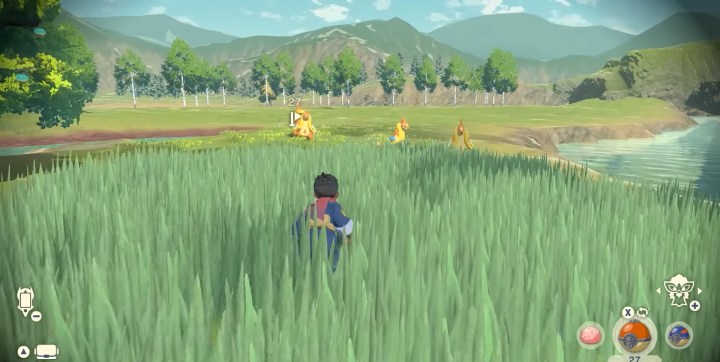Perhaps the most refreshing aspect of Pokémon Legends: Arceus is the combination of two (mostly) new features to the franchise: Open-world areas and being able to see Pokémon walking around the map without engaging them in battle. Both of these have been toyed with to some extent in various ways, but never fully fleshed out and made core to the Pokémon experience — until now. This simple change has completely altered the way trainers go about searching for Pokémon to catch, or avoiding battles altogether. An unforeseen consequence this change had was in a brand new take on an event from older titles called Mass Outbreaks.
Mass Outbreaks existed in prior games, going all the way back to the third-generation titles, but can now finally shine thanks to the technical improvements that come with with Pokémon Legends: Arceus. These events are not highlighted much by the game, if at all, but can serve some very important purposes if you understand them. Since the game doesn’t seem all that interested in explaining what Mass Outbreaks are, or how you can utilize them, we’ve put together this guide on everything you need to know about them in Pokémon Legends: Arceus.
See more
- What are alpha Pokémon in Pokémon Legends: Arceus?
- How to trade with friends in Pokémon Legends: Arceus
- Pokémon Legends: Arceus: How to expand your satchel space
What are Mass Outbreaks?

Mass Outbreaks in Pokémon Legends: Arceus are random events where one type of Pokémon will spawn in large numbers in a specific area. Rather than seeing just a few of a particular Pokémon, or none at all, you will find groups of around 10 or so of that Pokémon all clustered together and receive a little notification that you’re in the right spot.
You will be told a Mass Outbreak is occurring when you are leaving Jubilife Village, and even be shown an icon on the map for which region it is in and what Pokémon are part of the out break. Once you select that region, you can even pin down exactly where the outbreak is happening. These events don’t need to be unlocked or anything, and will just start happening as you play the game. You also don’t need to worry about the event ending over time. It will stay on your map so long as you don’t return to Jubilife Village.
So far, no one has been able to determine how rare or often Mass Outbreaks will happen statistically speaking, only that they’re random. Some players speculate that beating the main campaign increases the odds of them happening, but there’s no proof one way or another on that just yet.
How do Mass Outbreaks effect Shiny Pokémon?

Mass Outbreaks are cool events already, but all you Shiny Pokémon hunters out there will want to pay extra close attention to them since they increase your chances of finding a wild Shiny Pokémon more than anything else in Pokémon Legends: Arceus. Without getting too deep into it, normal odds of a Shiny appearing naturally in the world are about 1 in 4,000. During a Mass Outbreak, on the other hand, those odds increase to 1 in about 158. If you add in the other bonuses from Pokédex research levels, you can make those odds even better. Even on their own, though, Mass Outbreaks are the most efficient way you can go about hunting Shiny Pokémon in Pokémon Legends: Arceus.
Can you cause a Mass Outbreak?

So, Mass Outbreaks are useful for plenty of reasons, but are they only random events? Unfortunately, there are no methods you can use to force a Mass Outbreak to happen, let alone for a specific Pokémon you’re trying to get. On the other hand, there is one method you can use to at least speed up the process of getting this random event to happen.
If you’re really eager for a Mass Outbreak, whether hunting Shiny Pokémon or otherwise, the best option is to leave Jubilife Village for any of the game’s regions, then immediately return to the village. This will reset the random roll for a Mass Outbreak, giving you another shot at one happening. If there still isn’t one going on, or one you’re not interested in, simply repeat the process. Thankfull,y loading times in Pokémon Legends: Arceus are pretty quick so this isn’t a horrible process, though it’s still quite boring. Still, compared to how long it would normally take you to find Shiny Pokémon, for example, it is far faster.
What Pokémon can be in a Mass Outbreak?
What Pokémon you can find in a Mass Outbreak all depend on where it is taking place. Only Pokémon that naturally spawn in that area have a chance of creating a Mass Outbreak, and you can always tell what Pokémon you will find based on the icon for the outbreak you see on the map. At the same time, not every single species of Pokémon in each region can have a Mass Outbreak, though most can. If you’re waiting on a specific Pokémon to have a Mass Outbreak, check this list to make sure there’s even a possibility of it happening:
Obsidian Fieldlands outbreak Pokémon
- Abra
- Beautifly
- Bibarel
- Bidoof
- Buizel
- Buneary
- Cascoon
- Chansey
- Cherubi
- Chimchar
- Combee
- Dustox
- Eevee
- Floatzel
- Gastrodon
- Golbat
- Golduck
- Gyarados
- Happiny
- Kadabra
- Kricketot
- Kricketune
- Luxio
- Luxray
- Magikarp
- Mime Jr
- Monferno
- Mr. Mime
- Paras
- Parasect
- Pichu
- Pikachu
- Ponyta
- Psyduck
- Qwilfish
- Rapidash
- Scyther
- Shellos
- Shinx
- Silcoon
- Stantler
- Staraptor
- Staravia
- Starly
- Wurmple
- Zubat
Crimson Mirelands outbreak Pokémon
- Barboach
- Bonsly
- Budew
- Carnivine
- Chansey
- Combee
- Croagunk
- Gastly
- Geodude
- Golduck
- Goomy
- Graveler
- Grotle
- Happiny
- Haunter
- Hippopotas
- Hippowdon
- Kricketot
- Kricketune
- Lickilicky
- Lickitung
- Murkrow
- Pachirisu
- Paras
- Parasect
- Petilil
- Psyduck
- Rhydon
- Rhyhorn
- Roselia
- Skuntank
- Sliggoo
- Stunky
- Sudowoodo
- Tangela
- Tangrowth
- Teddiursa
- Togepi
- Toxicroak
- Turtwig
- Ursarin
- Whiscash
- Yanma
- Yanmega
Cobalt Coastlands outbreak Pokémon
- Aipom
- Ambipom
- Basculin
- Buizel
- Chansey
- Chatot
- Drapion
- Drifblim
- Drifloon
- Dusclops
- Duskull
- Finneon
- Floatzel
- Gastrodon
- Glameo
- Growlithe
- Happiny
- Lumineon
- Machoke
- Machop
- Magby
- Magmar
- Mantine
- Mantyke
- Octillery
- Piplup
- Prinplup
- Purugly
- Qwilfish
- Remoraid
- Sealeo
- Shellos
- Skorupi
- Spheal
- Staraptor
- Staravia
- Starly
- Tangela
- Tangrowth
- Tentacool
- Tentacruel
- Togepi
- Walrein
Coronet Highlands outbreak Pokémon
- Bonsly
- Bronzon
- Bronzor
- Budew
- Chansey
- Chimecho
- Chingling
- Clefairy
- Cleffa
- Croagunk
- Electabuzz
- Elekid
- Gabite
- Geodude
- Gible
- Gligar
- Golbat
- Goomy
- Graveler
- Gyarados
- Happiny
- Heracross
- Hippopotas
- Hippowdon
- Luxio
- Luxray
- Magikarp
- Misdreavus
- Nosepass
- Onix
- Rhydon
- Rhyhorn
- Roselia
- Rotom
- Scyther
- Shinx
- Skuntank
- Sliggoo
- Sneasel
- Stunky
- Sudowoodo
- Teddiursa
- Toxicroak
- Ursaring
- Voltorb
- Yanma
- Yanmega
- Zubat
Alabaster Icelands outbreak Pokémon
- Abomasnow
- Aipom
- Ambipom
- Avalugg
- Basculin
- Bergmite
- Bibarel
- Bidoof
- Braviary
- Bronzong
- Bronzor
- Chansey
- Chimech
- Chingling
- Drifblim
- Drifloon
- Dusclops
- Duskull
- Eevee
- Gabite
- Gardevoir
- Gastly
- Gible
- Glalie
- Gligar
- Happiny
- Haunter
- Kirlia
- Lickitung
- Machoke
- Machop
- Mamoswine
- Misdreavus
- Munchlax
- Piloswine
- Ralts
- Riolu
- Rufflet
- Sneasel
- Snorunt
- Snover
- Stantler
- Swinub
- Zoroark
- Zorua



